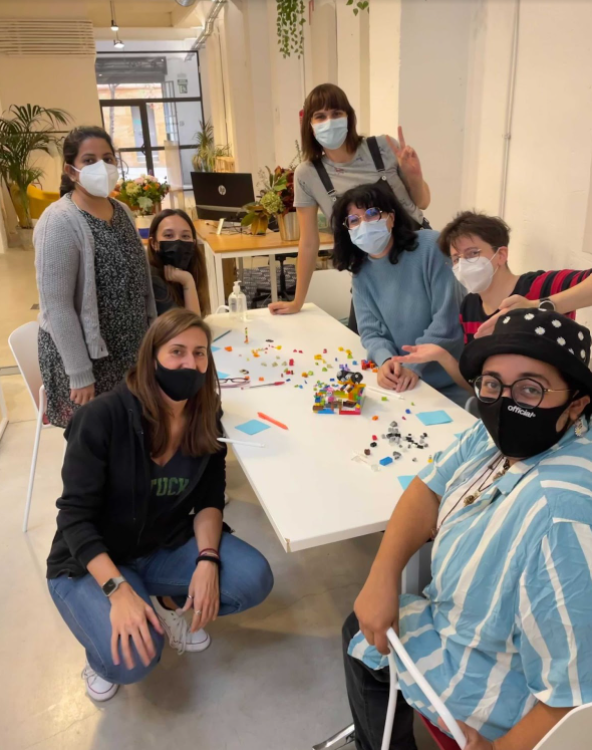Closing the Gender Gap in Tech involves – amongst many other things – making the industry more inclusive. For Bumble, one route to tackling inclusion and accessibility head on was to create the Bumble Tech Academy. Aideen Farrell, Senior Engineering Manager at Bumble, was a driving force in planning and launching the Academy.
So, how did you get into tech, as a career?
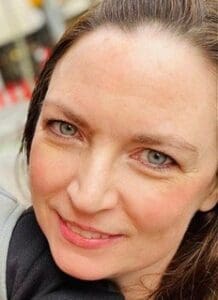 And what is it about that you love? I have always been interested in how stuff works. I loved physics at school and when the time came to choose a topic for university, electronics seemed like an interesting choice. Over time I shifted my focus to information technology and then specifically to Software. I left university with a degree in Software Engineering and have been working in tech ever since.
And what is it about that you love? I have always been interested in how stuff works. I loved physics at school and when the time came to choose a topic for university, electronics seemed like an interesting choice. Over time I shifted my focus to information technology and then specifically to Software. I left university with a degree in Software Engineering and have been working in tech ever since.
I love that almost any problem can be solved through tech. It’s engaging and creative and there is so much variety in terms of programming languages, styles, and domains. I love the persistent change. There are always innovative technologies to learn and new projects to take up. There is also a lot of opportunity for impact. Most of all, I love how portable IT skills are and the flexibility this has afforded me in terms of work hours and working location.
What attracted you to joining Bumble as a Senior Engineering Manager?
I had been feeling disillusioned for a while with the whole tech industry, the corporate career path and the frustrations that underrepresented groups experience navigating that. I resigned from my previous role as Director of Engineering at a large travel tech company and returned to university to upskill and give myself a new perspective! I had just finished a Masters in Artificial Intelligence when Bumble reached out about the senior engineering manager role.
I had been considering either joining a start-up or finding a role focused on the ethical use of AI. I was a little concerned that the Bumble position might be a step backwards, but I also saw it as an opportunity to transition back into the corporate world. I did some research into the company and felt inspired by the CEO, the company’s history, Bumble’s focus on ethics, and the empowerment of women. I also happily discovered that this role came with a terrific opportunity to build a team from scratch.
What prompted you to start the Bumble Tech Academy? And what was your role in the process?
The concept of the Tech Academy was already taking shape when I joined. There was a cross-collaboration between the social innovation, tech, and talent acquisition teams dedicated to bringing it to life. I was asked if I would like to participate in the work group and I jumped at the chance. My role in the process was to bring some fresh determination and to keep the momentum going. We believed so much in the concept that failing to bring it to life was never an option.
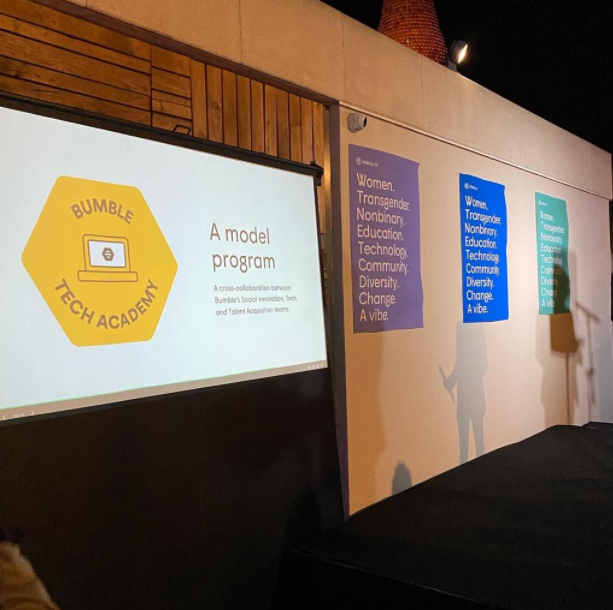 There were three fundamental aspects to the framework that we needed to get right.
There were three fundamental aspects to the framework that we needed to get right.
1) Find the right partner. This was quite a challenge but through a series of serendipitous events, CodeOp came to my attention and from the very first conversation it was clear they were the perfect fit.
2) Ensure our framework has enough training and support baked-in to really build confidence in the participants.
3) Provide full and continued financial support to the participants from the outset. Organisations very often sponsor boot camps in an effort to increase diversity, however, more often than not – candidates must support themselves during this training period, with no guarantee of a job upon completion. This approach is often either unfeasible or simply involves too much risk at an individual level. We wanted to absorb most, if not all, of that risk. Progress involves changing how we do things and even though we cannot really be sure yet that the risks will pay off we are highly confident that they will. I would love to see other organisations taking similar steps and showing full support and belief in women and other underrepresented groups who seek similar opportunities to transition into tech.
You had over 1,000 applications for this first round, just for 8 positions. What does this tell you about the female tech talent pipeline?
The “pipeline problem” is the theory that a gender disparity exists in tech because there aren’t enough members of underrepresented groups interested in, qualified in, or skilled in tech positions. Countless studies have shown this supposed lack of interest in technology to be a myth. Twenty years of experience in the industry has also led me to the same conclusion.
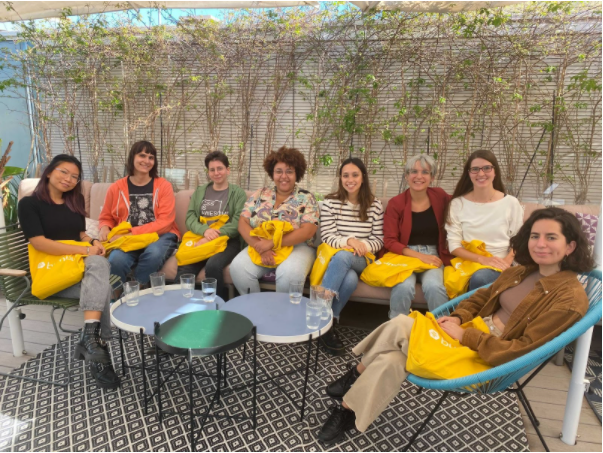 Focusing on the pipeline as the problem means not having to take immediate accountability for the biases in our own organisations, and this has resulted in the lack of representation we’re seeing in the tech industry. There are so many women and members of underrepresented groups who are interested in technology but simply have not had the opportunity or the encouragement to pursue it as a career in the past. There are many reasons cited for this, such as a lack of visible role models and the deeply ingrained gender career stereotypes.
Focusing on the pipeline as the problem means not having to take immediate accountability for the biases in our own organisations, and this has resulted in the lack of representation we’re seeing in the tech industry. There are so many women and members of underrepresented groups who are interested in technology but simply have not had the opportunity or the encouragement to pursue it as a career in the past. There are many reasons cited for this, such as a lack of visible role models and the deeply ingrained gender career stereotypes.
With the launch of the Bumble Tech Academy, we wanted to focus on the women who had missed out on tech due to the above-mentioned reasons, and to further focus on the barriers they might now face if they wished to transition into tech. We recognised that this was very often either financial or due to lack of representation. It has really come as no surprise that there were over one thousand applicants; there is so much interest out there and the value that these folks can bring to the industry is priceless.
Why was it important for you to partner with CodeOp?
It was important to find a partner that was absolutely committed to the concept as much as we were. We had preliminary discussions with quite a few Bootcamp providers, however, CodeOp really stood out. Their goals were entirely aligned with those of Bumble. They had the vision of a long-term collaboration and of growth. They were really supportive in designing a bespoke bootcamp that truly met our needs. CodeOp was founded in 2018 specifically to help solve the gender disparity problem in the tech space. They are the first international tech school for women, transgender, and non-binary individuals and support those who want to transition to or upskill in tech. The partnership is the perfect match, and we feel lucky to have found them.
What’s been your greatest highlight of the process so far?
Honestly, every milestone is the new greatest highlight. From reviewing the applications, meeting the participants, hearing their stories, and seeing the results of the first coding projects – it’s a passion project for everyone involved so every moment is a highlight.
What role do you think social-economic factors have in perpetuating the gender gap in tech?
This is a difficult one as there are so many factors perpetuating the gender gap. A quantitative survey of 6,009 girls and young women from ages 10-30 points to societal norms and lack of role models. Homogeneous recruitment techniques also play a part. Social-economic factors definitely play a role for underrepresented groups, particularly in countries where underfunded schools are less likely to have enough resources to support student engagement in STEM. Access to computers and the internet is not universal and there are many studies that show evidence of a ‘digital divide’ between regions, areas, and neighbourhoods. According to this report, a key predictor of who enters the tech industry is early access to computing courses. Economic factors also hold back those who previously faced barriers and now wish to transition into tech even years later when they feel more empowered to do so.
What do you think companies should be doing to actively bring women into tech roles?
Tech companies should take a proactive approach to inviting and recruiting women and folks from underrepresented backgrounds. It’s easy to say that you value diverse talent but it takes accountability and commitment to integrate the systems needed to cultivate diverse and inclusive hiring practices. There’s also a tendency in the world of tech and business to advise underrepresented groups to conform to “play the game,” and to “be pragmatic” which is essentially asking women and other underrepresented groups to change their perceptions, opinions, and behaviours in ways that are consistent with the white male group norms, that have dominated the industry. This doesn’t reflect the spirit of true diversity.
From a philosophical perspective, pragmatism encompasses a willingness to compromise rather than to focus on dismantling policies at the structural or institutional level. Asking underrepresented groups to “apply for more roles”, “self-promote”, “be more confident” or essentially to behave more like the white male norm in the tech space – may seem like a quick fix but it’s extremely unhelpful as it places the responsibility of a resolution onto the group already burdened by the issue.
The tech industry must take accountability for the barriers that women and underrepresented groups have faced for a long time and find ways to alleviate them. Those solutions must not require conformity to those behaviours that, when we think about it, have devised and reinforced the barriers in the first instance. We behave as we do largely because of the experiences we have encountered in the society in which we live. Historically – society (and the tech industry) has, through deeply ingrained gender stereotypes, taught us, women, that STEM is not for us.
The tech industry has all of the studies and information available to take that burden off women and other underrepresented groups. What we need now is a collective acknowledgement that we, the tech industry, must come together and take steps to rectify that. Moving forward, we hope that the work we’re doing with the Bumble Tech Academy helps to encourage other peers within the industry to invest in creating a more diverse and equitable space for women and underrepresented groups in STEM.
Finally: what advice would you give to women in tech who want to work for companies that truly value diversity and inclusion?
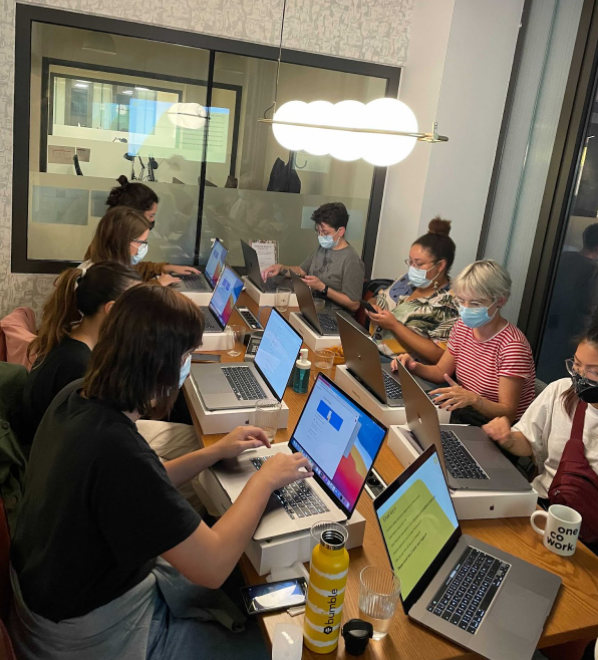
Here are some of my recommendations:
- Have a look at the company website, and check to see if they have an independent D&I department.
- What is the tone of the D&I content on the website or on its social media?
- Are there employee resource groups?
- Does the company share its diversity metrics?
- How diverse is the company at all levels? Across all departments?
- Are there any red flags in the job descriptions?
- Is the company applying homogeneous recruitment techniques?
- What benefits does the company offer, both in terms of maternity and paternity leave?
- Finally, it’s so important that the company is being fully transparent and takes accountability for any disparities when it comes to diversity and inclusion. As a prospective employee, you should feel confident that there is both an intent and a plan for improvement.



